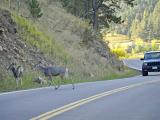A study that involved feeding ticks blood spiked with chronic wasting disease (CWD) prions and testing ticks and ear samples taken from infected wild white-tailed deer suggests that the parasites can indirectly transmit the disease.
For the University of Wisconsin at Madison-led study, researchers gave blood to male and female Ixodes scapularis (black-legged, or deer) ticks using a membrane feeder and a diluted CWD-infected brain sample from a hunter-harvested deer.
Caused by infectious prions (misfolded proteins), CWD is a fatal neurodegenerative disease affecting cervids such as deer, elk, and moose. While CWD isn't known to infect humans, some experts fear it could mimic bovine spongiform encephalopathy ("mad cow" disease). Cervids can host many ticks and may ingest them while grooming each other.
"Natural modes of indirect transmission of CWD among free-ranging cervids remain poorly examined and may perpetuate endemic increases and broad geographic spread of the disease," the researchers wrote.
Single tick may carry infectious dose
In the first part of the experiment, the scientists demonstrated through artificial membrane feeding and real-time quaking-induced conversion assay (RT-QulC) that ticks can ingest and excrete CWD prions.
For the second phase of the study, the investigators gathered ticks and ear samples from 174 tick-infested deer heads that hunter harvested in a CWD-endemic area of Wisconsin. The number of ticks attached to 15 heads (0.8%) that tested positive for CWD ranged from 2 to 8, compared with 3 to 16 in the CWD-negative heads.
RT-QulC and protein misfolding cyclic amplification of the pooled tick samples from infected deer showed seeding activities (propagation and transmission) equivalent to 10 to 1,000 nanograms (ng) of lymph node collected from the throats of the deer upon which they were feeding. The findings indicated a CWD prevalence of 7.0% to 40.0% in ticks that had fed on the deer. The ear samples also showed evidence of seeding activity.
The researchers used the predicted mass of seeding material and the previously reported oral infectious CWD dose to estimate the infectious dose of a single tick that ingested blood from an infected deer. "Estimates revealed a median infectious dose range of 0.3–42.4 [ng] per tick, suggesting that ticks can take up transmission-relevant amounts of PrPCWD [CWD prions] and may pose a CWD risk to cervids," they wrote.
Indirect CWD transmission likely has a central role in CWD dynamics, possibly through a combination of ingested or inhaled contaminated soil, consumption of contaminated plants, or mucosal contact with contaminated objects or environmental materials, the author said.
"We have identified a potential mechanical vector of CWD not previously evaluated for WTD [white-tailed deer], with implications for host behavior that may influence CWD exposure events," they wrote. "Land use change and shifts in regional climate regimes may result in higher tick infestations on cervids and contemporary range expansion for different tick species, potentially increasing the likelihood of this type of exposure event among WTD and other cervids."
We have identified a potential mechanical vector of CWD not previously evaluated for WTD [white-tailed deer], with implications for host behavior that may influence CWD exposure events.
The researchers called for future research involving larger I scapularis samples and other tick species collected from deer and other wild cervid species across North America, as well as behavioral studies on mutual cervid grooming frequency, alterations, and preferences across species.
Three states confirm more cases
In related news, last week Iowa and Maryland published their 2022 CWD surveillance reports, and Ohio today issued a news release detailing more detections in two counties.
- The Iowa Department of Natural Resources (DNR) confirmed that 96 deer tested positive for CWD, and three counties—Jasper, Grundy, and Lucas—were affected for the first time in 2022. Rachel Ruden, DVM, with the DNR, said department officials previously thought that Jasper County, in the central part of the state, was too far away from confirmed cases to be affected at this point. "Based on data coming out of other states, we've learned that deer can travel much greater distances than previously thought—75 to 100 miles—so there really isn't any place in Iowa where this disease can't turn up," she said. Since CWD was first detected in Iowa in 2013, 259 positive cases have been identified.
- The Maryland DNR reported that 38 deer harvested in Allegany, Carroll, Frederick, and Washington counties tested positive for CWD in 2022. The state first confirmed CWD in 2011, with surveillance yielding a total of 171 cases.
- The Ohio DNR said today that 11 more deer tested positive for CWD in Marion and Wyandot counties after the most recent hunting season and through targeted removal efforts in February and March. The first CWD cases were detected in the state in 2020, for a total of 22 cases, all in those two counties.
To date, CWD has been found in 30 US states and four Canadian provinces.


















